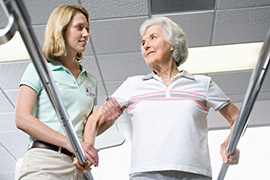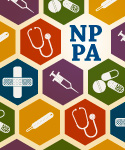March 22nd, 2016
The Art of Listening – Beyond Your Patient
Charity Maniates, MSPA, MPH, PA-C
Opening the door slowly, I poked my head in the dimly lit room and glimpsed my patient’s petite frame leaning forward in her bed. I sat on the edge of the mattress, noting how tired the patient looked. The physical therapist was concluding the last session prior to her discharge that afternoon. After inquiring how the session went, the therapist paused a moment and tentatively said that the patient had difficulty breathing today and had to complete her exercises in bed. The patient was at skilled rehabilitation for recurrence of Clostridium difficile and, although she lacked endurance, had not experienced dyspnea. The team’s plan was to discharge her home with her daughter that day. She had been clinically stable and I had efficiently completed her entire discharge. But instead, I ordered a chest x-ray, which showed an infiltrate, and her discharge was delayed for treatment of pneumonia.
In this situation, I could have discharged the patient home, attributed the patient’s dyspnea to just feeling tired, and simply had her follow-up with her PCP in one week. Realistically, the patient would have returned to the ED in 24 hours for rehospitalization. The therapist’s observations were key in my decision-making and ultimately led to a better outcome.
 This scenario happens all too often. A multidisciplinary team member (e.g., a therapist, CNA) or a family member notes changes in a patient’s baseline that may be subtle or inconsistent. It can be easy to flippantly attribute such vague symptoms as self-limiting or irrelevant. However, a dismissive response to a team member’s or relative’s concern conveys that you prefer no communication and is degrading. That approach only causes breakdown and may delay needed early intervention or treatment for a patient.
This scenario happens all too often. A multidisciplinary team member (e.g., a therapist, CNA) or a family member notes changes in a patient’s baseline that may be subtle or inconsistent. It can be easy to flippantly attribute such vague symptoms as self-limiting or irrelevant. However, a dismissive response to a team member’s or relative’s concern conveys that you prefer no communication and is degrading. That approach only causes breakdown and may delay needed early intervention or treatment for a patient.
One busy morning, a physical therapy aide followed me to the nurses’ station and wanted to let me know that a patient seemed quite fatigued and unable to perform therapy. The 86-year-old patient had just been admitted to rehab a few days prior for generalized weakness after a fall resulting in a pelvic fracture. I remarked that it wouldn’t be out of the ordinary for her to be weak, but I sensed that the physical therapy aide was not satisfied. She showed me the patient’s vitals signs on a scrap of paper. “I know her vital signs are stable but I can hear her wheezing and she’s so weak.” This prompted me to see the patient that morning. The patient had diffuse rales and lower-extremity pitting edema, so I initiated diuretics and ordered a ProBNP (which was elevated) and an echocardiogram. Clinically, she improved substantially over the next few days and was ambulating with a walker. Because the physical therapy aide was persistent in her communication, treatment was initiated before the patient’s symptoms progressed. Early intervention in the elderly is essential, as decline happens swiftly and can lead to a transfer to the ED.
 At end of life, those providing daily care are especially sensitive to subtle changes in patients’ breath sounds, respiratory rate, and overall responsiveness. These cues prompt shifting in medications or pain management or indicate that death is approaching. I was engaged in reviewing a long list of medications for a new patient when a CNA approached me. She was amazed that a hospice patient had been alert and talking the day before but had refused all her oral medications that morning and could not be roused. Normally, this report would be given to the nurse, but the one nurse on the unit was not available. My train of thought was derailed, and I had to shift my plan for the morning. I stopped by the patient’s room, and she was unresponsive with 10-20 second periods of apnea, indicating that death was close. She had declined further since early morning.
At end of life, those providing daily care are especially sensitive to subtle changes in patients’ breath sounds, respiratory rate, and overall responsiveness. These cues prompt shifting in medications or pain management or indicate that death is approaching. I was engaged in reviewing a long list of medications for a new patient when a CNA approached me. She was amazed that a hospice patient had been alert and talking the day before but had refused all her oral medications that morning and could not be roused. Normally, this report would be given to the nurse, but the one nurse on the unit was not available. My train of thought was derailed, and I had to shift my plan for the morning. I stopped by the patient’s room, and she was unresponsive with 10-20 second periods of apnea, indicating that death was close. She had declined further since early morning.
Due to the CNA’s report early in the day, I engaged in a meaningful interaction with the patient’s daughter regarding end-of-life care, and a clergy visit was initiated. It would have been impossible to orchestrate this if I had been paged in the middle of the night. My patient’s last 24 hours of life were comfortable, surrounded by family ushering her out of this world to another.
The hierarchy in medicine that results in devaluing of workers with less education is unprofessional and does not support a team-based culture. Healthcare systems need to empower multidisciplinary team members to vocalize concerns and validate their roles rather than diminish the work they do as menial and unimportant. Establishing rapport with these health professionals encourages them to feel comfortable approaching other providers. Being approached can be irritating when you’re attempting to return a page, writing an order, or reviewing a chart. But in my experience, the few extra minutes to stop and communicate can potentially change a patient’s course significantly.


